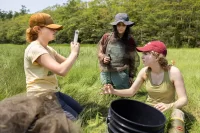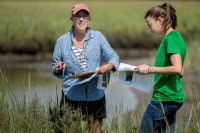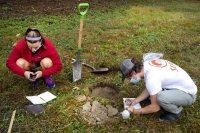
“It’s just a beautiful place,” says Professor of Earth and Climate Sciences Beverly Johnson, offering a simple but apt description of a coastal marsh where she and Bates students have done research for more than two decades.
In recent years, Johnson’s summer research, done alongside Bates students, has been studying blue carbon sinks at four Maine sites, including Bates Morse-Mountain Conservation Area, the aforementioned “beautiful place,” which Bates oversees as a place for conservation, preservation, research, and education.
Theophil Syslo/Bates College
Johnson’s research recently contributed to a groundbreaking report from the Environmental Protection Agency on blue carbon — the carbon sequestered in vegetated coastal areas.
The EPA report that Johnson co-authored was the first-ever regional assessment of blue carbon sinks from Long Island, N.Y., to Maine. The Maine data comprised 25 percent of the overall assessed habitat in the report, and 80 percent of that data came from Johnson’s lab.
“I’ve been studying in BMMCA for 22 years, and it’s always quite different when I go in. I learn something new every time.”
Beverly Johnson
This summer, Johnson’s team measured greenhouse gas fluxes in salt marshes, looking at carbon dioxide going into plants and soils in healthy marshland — as well as methane, a greenhouse gas released from degraded coastal systems.
“We’re trying to understand these degraded parts of salt marshes, if there’s an opportunity to restore them,” Johnson said. “If we restore a salt marsh that is degraded right now, can we turn it back into a carbon sink? Because healthy salt marshes are very valuable.”
Engaging students as research colleagues reflects a guiding philosophy for many Bates professors. “Hands-on activities, hands-on research with students up through senior theses prepares students very well for a world and life beyond Bates.”
And it never gets old. “I’ve been studying in BMMCA for 22 years, and it’s always quite different when I go in. I learn something new every time.”
This article was prepared by Bates College using Federal funds under award NA22OAR4170121 from the University of Maine System/Maine SeaGrant, U.S. Department of Commerce. The statements, findings, conclusions, and recommendations are those of the author(s) and do not necessarily reflect the views of the University of Maine System/Maine SeaGrant or the U.S. Department of Commerce.




